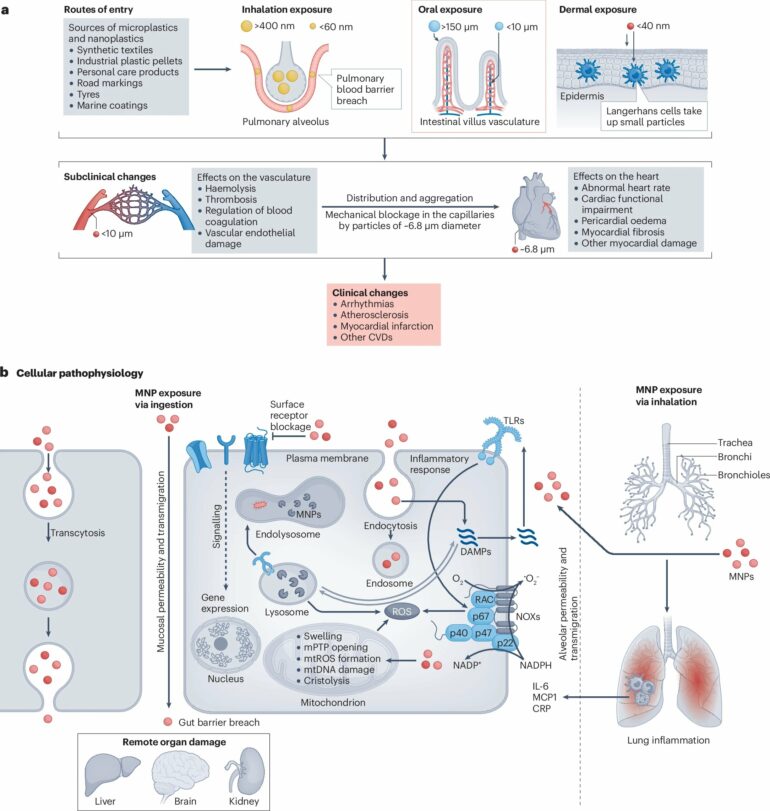by Veronika Wagner, Universitätsmedizin der Johannes Gutenberg-Universität Mainz
Pesticides, heavy metals, micro- and nanoplastics in the soil and environmentally harmful chemicals can have a detrimental effect on the cardiovascular system, according to a review paper published today in Nature Reviews Cardiology.
The article provides an overview of the effects of soil and water pollution on human health and pathology and discusses the prevalence of soil and water pollutants and how they negatively affect health, particularly the risk of cardiovascular disease.
The key points of this publication are:
Illnesses related to chemical pollution of the soil, water and air are responsible for an estimated 9 million premature deaths annually, which equates to 16% of all global deaths; half of these deaths are of cardiovascular origin.
Degradation of the soil threatens the health of at least 3.2 billion people (40% of the global population), whereas more than two billion people (25% of the global population) live in countries that are particularly affected by water pollution.
Eco-disruptive causes of soil and water pollution include deforestation, climate change, airborne dust, over-fertilization and unhealthy city designs.
Pollution by heavy metals, pesticides, and micro- and nanoplastics cause cardiovascular damage, by inducing oxidative stress, inflammation, and impairing circadian rhythms.
Exposure to chemicals (such as heavy metals, solvents, dioxins and pesticides) at workplaces, through consumer products or indirectly via environmental contamination contributes to endothelial dysfunction and cardiovascular disease.
“Soil contamination is a much less visible danger to human health than dirty air,” state the two main authors of the study, Prof. Dr. Thomas Münzel, Senior Professor, and Prof. Dr. Andreas Daiber, Head of the Molecular Cardiology Research Group at the Department of Cardiology at University Medical Mainz.
“But the evidence is mounting that pollutants in soil as well as in water may damage cardiovascular health through a number of central mechanisms that have been identified to play a key role in the atherosclerotic process such as inflammation of the vasculature, increased oxidative stress, but also the disruption of the body’s natural clock causing vascular (endothelial) dysfunction that may lead to the initiation or progression of atherosclerotic disease.
“An important reason for writing this review article was therefore to strongly encourage cardiologists to consider environmental factors that could influence their patients’ risk,” adds Thomas Münzel.
The potential hazards of contaminated airborne dust are also becoming increasingly important—commonly known as Sahara or desert dust, for example. About 770,000 cardiovascular deaths per year can be attributed to dust pollution.
“Unfortunately, climate models predict that this airborne dust will increase significantly and that air quality will deteriorate as the planet warms,” comments Prof. Dr. Jos Lelieveld from the Max Planck Institute for Chemistry.
Controlling soil and water pollution is crucial to reducing cardiovascular risk, according to the authors. Key strategies include reducing exposure to harmful chemicals through improved water filtration, air quality management, and adherence to good agricultural practices.
Efforts such as the European Commission’s zero-pollution vision for 2050 aim to significantly reduce pollution levels, contribute to healthier ecosystems and reduce the burden of cardiovascular disease.
Promoting sustainable urban design, reducing the use of harmful pesticides and improving environmental regulations worldwide are also essential to tackle the causes of soil and water pollution. These measures not only protect ecosystems, but also public health, particularly by reducing the incidence of cardiovascular disease caused by pollution.
More information:
Thomas Münzel et al, Soil and water pollution and cardiovascular disease, Nature Reviews Cardiology (2024). DOI: 10.1038/s41569-024-01068-0
Provided by
Universitätsmedizin der Johannes Gutenberg-Universität Mainz
Citation:
Soil and water pollution: An invisible threat to cardiovascular health (2024, September 25)



